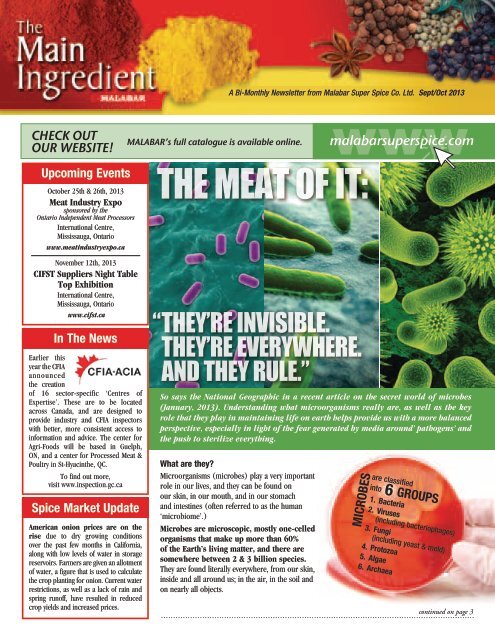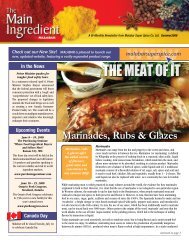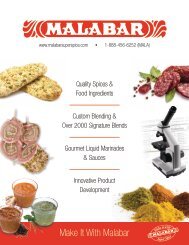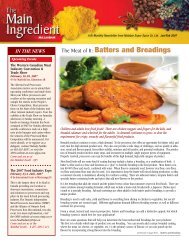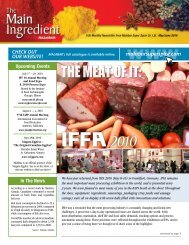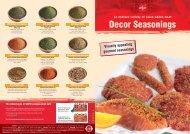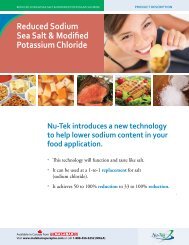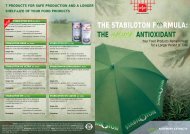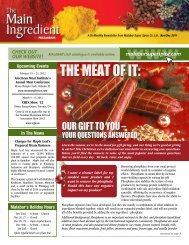THE MEAT OF IT: - Malabar Super Spice
THE MEAT OF IT: - Malabar Super Spice
THE MEAT OF IT: - Malabar Super Spice
You also want an ePaper? Increase the reach of your titles
YUMPU automatically turns print PDFs into web optimized ePapers that Google loves.
Check out<br />
our website!<br />
Upcoming Events<br />
October 25th & 26th, 2013<br />
Meat Industry Expo<br />
sponsored by the<br />
Ontario Independent Meat Processors<br />
International Centre,<br />
Mississauga, Ontario<br />
www.meatindustryexpo.ca<br />
<strong>Malabar</strong>’s full catalogue is available online.<br />
A Bi-Monthly Newsletter from <strong>Malabar</strong> <strong>Super</strong> <strong>Spice</strong> Co. Ltd. Sept/Oct 2013<br />
The Meat of It:<br />
www<br />
malabarsuperspice.com<br />
November 12th, 2013<br />
CIFST Suppliers Night Table<br />
Top Exhibition<br />
International Centre,<br />
Mississauga, Ontario<br />
www.cifst.ca<br />
In The News<br />
Earlier this<br />
year the CFIA<br />
announced<br />
the creation<br />
of 16 sector-specific ‘Centres of<br />
Expertise’. These are to be located<br />
across Canada, and are designed to<br />
provide industry and CFIA inspectors<br />
with better, more consistent access to<br />
information and advice. The center for<br />
Agri-Foods will be based in Guelph,<br />
ON, and a center for Processed Meat &<br />
Poultry in St-Hyacinthe, QC.<br />
To find out more,<br />
visit www.inspection.gc.ca<br />
<strong>Spice</strong> Market Update<br />
American onion prices are on the<br />
rise due to dry growing conditions<br />
over the past few months in California,<br />
along with low levels of water in storage<br />
reservoirs. Farmers are given an allotment<br />
of water, a figure that is used to calculate<br />
the crop planting for onion. Current water<br />
restrictions, as well as a lack of rain and<br />
spring runoff, have resulted in reduced<br />
crop yields and increased prices.<br />
“They’re invisible.<br />
They’re everywhere.<br />
And they rule.”<br />
So says the National Geographic in a recent article on the secret world of microbes<br />
(January, 2013). Understanding what microorganisms really are, as well as the key<br />
role that they play in maintaining life on earth helps provide us with a more balanced<br />
perspective, especially in light of the fear generated by media around’ pathogens’ and<br />
the push to sterilize everything.<br />
What are they?<br />
Microorganisms (microbes) play a very important<br />
role in our lives, and they can be found on<br />
our skin, in our mouth, and in our stomach<br />
and intestines (often referred to as the human<br />
‘microbiome’.)<br />
Microbes are microscopic, mostly one-celled<br />
organisms that make up more than 60%<br />
of the Earth’s living matter, and there are<br />
somewhere between 2 & 3 billion species.<br />
They are found literally everywhere, from our skin,<br />
inside and all around us; in the air, in the soil and<br />
on nearly all objects.<br />
Microbes<br />
are classified<br />
6<br />
into groups<br />
1. Bacteria<br />
2. Viruses<br />
(including bacteriophages)<br />
3. Fungi<br />
(including yeast & mold)<br />
4. Protozoa<br />
5. Algae<br />
6. Archaea<br />
continued on page 3
The Butcher’s Block:<br />
Is it Wood or Plastic?<br />
We’ve been conditioned to believe that cutting boards<br />
used for raw meat should be plastic – in theory<br />
they’re easier to clean, disinfect & less likely to crosscontaminate<br />
other foods. But is this true?<br />
Two graduate students, Dean Cliver and Nese Ak,<br />
started out in 1993 to develop means of disinfecting<br />
wooden cutting surfaces at home, so they would be<br />
‘almost as safe as plastics’. Their findings, however,<br />
surprised them, and the food safety community<br />
at large. In short, their initial assumption was<br />
potentially all wrong – were plastic cutting boards<br />
in fact inherently safer than wood?<br />
Cliver & Ak found that disease bacteria were not recoverable<br />
from wooden cutting boards in a short time after they were<br />
applied, while bacteria were easily recoverable from plastic<br />
surfaces for long afterwards, and that older, knife-scarred<br />
plastic surfaces remained virtually impossible to clean or<br />
disinfect, regardless of the process used, especially when food<br />
residues like chicken fat were present.<br />
Although bacteria that had disappeared from the wood surfaces<br />
were found alive inside the wood for some time they seemed to<br />
be unable to escape, or to reproduce, and eventually died off.<br />
(Other cutting surfaces available like glass or stainless steel were<br />
not investigated, simply because of the destructive effects these<br />
surfaces can have on the sharp cutting edges of knives.)<br />
The experiments were conducted with more than 10 species<br />
of hardwoods, and 4 plastic polymers, as well as hard rubber.<br />
Bacteria tested included E Coli, Salmonella, Campylobacter,<br />
Listeria & Staphylococcus.<br />
While Cliver and Ak’s experiments were meant to replicate the<br />
home kitchen, Cliver believes they are relevant to a processing<br />
or commercial environment. In fact, after replicating his<br />
research, both the USDA and the FDA have changed their<br />
From the Lab<br />
food prep recommendations to include cutting boards<br />
made of maple or other hardwood surfaces. “Just remember<br />
that any good you gain from using wood is completely negated if<br />
you don’t clean the board, says Cliver. “Don’t let food residues dry<br />
on the surface,” he says. “When I use wood, I clean it promptly.”<br />
The information provided is accurate and reliable<br />
to the best of our knowledge, but is offered solely<br />
for consideration, without warranty or guarantee.
“They’re invisible. They’re everywhere. And they rule.”<br />
Microbial growth is dependent on nutrients, oxygen, water,<br />
temperature, pH, light and chemicals, variations of which can<br />
increase microbial growth, or slow it down, or even injure or<br />
kill the microbes. Nutrients required for microorganisms to grow<br />
include carbohydrates, fats, proteins, vitamins and minerals.<br />
Different microbes have different oxygen requirements, as some<br />
require free oxygen to grow, while others can only grow in the<br />
absence of free oxygen. Water is also required, but not pure<br />
water. The amount of available water (aw) is important, and most<br />
spoilage bacteria require a minimum aw of 0.90.<br />
Microbes are able to grow in a wide range of temperatures,<br />
with the best growing temperatures at or near room and body<br />
temperature. The ideal pH environment for most bacteria is<br />
between 4 and 9. Yeasts and molds are more tolerant in acidic<br />
solutions. Ultraviolet light and chemicals such as hydrogen<br />
peroxide and chlorine can also affect the growth of microbes.<br />
Microbes that cause disease are called pathogens, however<br />
microbes are also necessary for human life. They help us<br />
to digest our food (and protect our intestinal walls), guide our<br />
immune system and combat deadly germs.<br />
Microbes are one of<br />
the hottest topics in food<br />
In the food industry, microbes are<br />
used to make bread, cheese, yoghurt<br />
and wine. The process of fermentation<br />
incorporates different microbial strains<br />
that improve taste, texture and smell,<br />
and can also reduce the growth of<br />
unwanted food microbes (as with<br />
the use of lactic acid cultures in the<br />
production of dry cured meat products).<br />
Chefs around the world are getting<br />
excited about using fermentation to<br />
add flavour. Molecular gastronomy (or<br />
molecular cuisine) is the new ‘science’<br />
of cooking – focusing on the physical<br />
& chemical transformations that occur<br />
with ingredients. It is commonly used to<br />
describe a style of cuisine in which chefs<br />
explore new culinary possibilities in the<br />
kitchen by embracing food science to<br />
create innovative new foods.<br />
Molecular gastronomy is now looking to bacteria for<br />
new flavours. In fact, last March in a seminar held as part of<br />
the London Gastronomy Seminars entitled “Microbial ecology,<br />
fermentation and flavour”, the guest speakers were a combination<br />
of renowned microbiologists (Drs. R. Dutton and Ben Wolfe),<br />
and a chef (Chef Dan Felder). (For more information, see www.<br />
londongastronomyseminars.com.)<br />
Fermentation may also change how we sweeten our food.<br />
The manufacturers of Stevia (the high-intensity sweetener derived<br />
from the stevia leaf) have begun testing that involves using the<br />
process of fermentation on stevia leaves to provide a more<br />
functional and economical sweetener.<br />
With so many advances in science along with the global<br />
interest in foods and flavours, it is important that we<br />
understand that microbes are important to our health,<br />
and the health of our planet around us, and to our<br />
continued enjoyment of food!<br />
Did You Know?<br />
continued from page 1<br />
• Some microbes are so small that 25,000 of them<br />
placed end-to-end would span less than one inch.<br />
• The microbes in your body outnumber your own cells<br />
by ten to one.<br />
• The microbes in your body can weigh as much as<br />
your brain – approximately 3 pounds in an average<br />
adult.<br />
• Many standard vitamins used in dietary supplements<br />
are produced by fermentation, including CoQ10.<br />
References: 1.) Basic Food Microbiology, Rushing, Curtis, Fraser, Green, Pilkington, Ward & Turner, Department of Food Science, North Carolina State University.<br />
2.) The Secret World of Microbes, Nathan Wolfe, National Geographic, January 2013, pg 136-147
Starter cultures<br />
… microbes at work …<br />
OUR PRESIDENT’S<br />
Message<br />
We’re pleased to finally announce the winner of the Great<br />
Canadian Meat Contest!<br />
Starter Cultures are microbial preparations that<br />
accelerate the fermentation process through<br />
acidification (mainly with the production of lactic<br />
acid). Danisco is world renowned for excellence in<br />
maturation starter cultures. <strong>Malabar</strong> is the exclusive<br />
distributor of Danisco’s starter cultures in Canada.<br />
Here are our two most popular meat starter cultures:<br />
TEXEL ® SP-Elite<br />
A unique blend of over 4 different bacteria together with<br />
yeast for a mild acid taste, enhanced colour and full flavor<br />
and aroma. (Available in a 20 g pouch for 200 kg meat<br />
batch.)<br />
TEXEL ® SP-362<br />
This starter culture allows for very fast texturizing speed,<br />
and is great for snack salamis with a balanced, tangy,<br />
North European flavour. (Available in a 20 g pouch for<br />
500 kg meat batch.)<br />
We can also help with technical support and advice. To<br />
get started, see our website for reference pages on using<br />
starter cultures, and a troubleshooting guide for fermented<br />
sausages. Look for www.malabarsuperspice.com/danisco.<br />
For more information on any of the above,<br />
contact us at 1-888-456-6252, or<br />
email csr@malabarsuperspice.com.<br />
Our winner created something completely different. Mike<br />
Lenover from Lenover’s Quality Meats & Seafoods Ltd<br />
entered Uncle Walt Lenover’s Chocolate Coated Bacon,<br />
made with Lenover’s home-cured #1 Side Bacon, cooked to a<br />
crispy finish, then coated with Régine’s Finest Dark Chocolate.<br />
Mike debuted the first production of Lenover’s chocolate<br />
bacon during the preparations for his eldest daughter’s<br />
wedding, and it’s been a hit ever since! (What’s the greatest<br />
thing about it? Well, it’s sweet AND salty, and of course, it<br />
tastes like bacon!)<br />
Our winner will receive a copy of the River<br />
Cottage Meat Book, one of my favourite<br />
reads! Congratulations & here’s to<br />
Canadian meat dishes!<br />
All the best, from <strong>Malabar</strong><br />
Doris Valade<br />
President<br />
<strong>Malabar</strong> <strong>Super</strong> <strong>Spice</strong> Co. Ltd.<br />
Did You Know?<br />
A new social networking site for<br />
the meat industry was launched in<br />
May of this year - SocialMeatia.com - as a niche social networking<br />
site for farmers, organizations, restaurants, chefs, butchers and<br />
consumers to connect and celebrate everything meat.<br />
Look for our next edition in Nov/Dec 2013.<br />
<strong>Malabar</strong> <strong>Super</strong> <strong>Spice</strong> Co. Ltd., 459 Enfield Road, Burlington, Ontario<br />
L7T 2X5 www.malabarsuperspice.com<br />
For more information on any of the subjects covered in <strong>Malabar</strong>’s newsletter, or to suggest topics you’d like to see covered<br />
in future editions, please contact Sara Alexander at marketing@malabarsuperspice.com.<br />
<strong>Malabar</strong> takes your privacy very seriously, and we do everything in our power to safeguard it. We NEVER rent, sell,<br />
lend or otherwise circulate our mailing lists or other contact information to anyone outside of <strong>Malabar</strong>.<br />
<strong>Malabar</strong> is certified to provide<br />
Halal products, and is proud to<br />
be HACCP accredited.<br />
<strong>Malabar</strong> <strong>Super</strong> <strong>Spice</strong> is a proud<br />
supporter of Jeremy Hughes and<br />
Team Hughes Racing.<br />
www.10hughesracing.com


